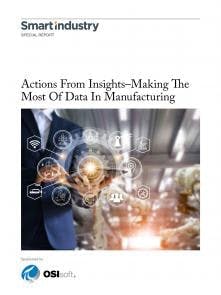Have you heard about the pots of gold?
The pots-of-gold stories are commonly told in this era of digitalization, when business owners are capable of gleaning unprecedented information from their machines. And, yes, there is (figurative) gold in that machine data, but claiming it requires time, strategy and expertise.
Data, by itself, is worthless. Just streams of information that mean nothing. And taking raw data from machines and shoving it into an analytics platform doesn’t work. That’s fool’s gold.
The value comes from contextualizing the data coming from smart machines—putting it in context, applying meta-data on top of it and analyzing it holistically within the framework of the full enterprise, ideally paired with insights from people on the factory floor who understand the environment from which this data comes.
Pain points
There are common challenges we see across industries, which prompt the turn to data as a solution. These same pain points are experienced by enterprises large and small. It’s discouraging, for sure, but there is solace in the knowledge that obstacles usually drive new efficiencies.
So, what are the common problems?
Most people running operations today say they are fighting fires—spending less time optimizing efforts because they are busy merely trying to keep things running.
Likewise, data is often not consistent between systems. The integration point is in somebody’s head. (And this human integration strategy is not a good one.)
There can be an unproductive cycle between the PI System and advanced analytics, a disharmony that inhibits sustainable success. Disorganized data results in resource-sapping data engineering (in the best-case scenario) and wrong conclusions if unchecked.
In the ideal setup, PI provides a place to operationalize insights so you don’t have to run to a variety of tools for each decision. You can employ specialized tools where they make sense, building a bank of insights into PI so anyone can act on them.
And then there are the issues with aging assets and the departure of domain expertise. Our recent study with oil, gas and renewables enterprises found 75% of asset owners are expecting to lose expertise in coming years, just as we are witnessing the return of domestic manufacturing. And, as you’re likely aware, old assets and aging expertise partnered with new technology and new assets is a recipe for chaos.
There will never be truly homogenous environments; that’s a given. We will always work in industrial environments with old and new assets containing a variety of technologies. But with the data-infrastructure approach, data from new equipment can be dropped into the infrastructure and organized with context, even accounting for that disparate nature of components. When data is particularly inconsistent, it is particularly important to have proper aggregation and analysis if you intend to generate applicable insights.
Some recent projects we have worked on exemplify these challenges:
- Auto-supplier Gestamp suffered quality inconsistencies before finding the root cause in the welding process after instituting narrow process parameters.
- Food-giant Kellogg’s Industry 4.0 initiative focused on improving quality for customer benefit, and reducing its energy footprint while improving its bottom line. They leveraged the existing PI system to fully capitalize on machine data.
- Garant, a manufacturer of a products ranging from wheels to gardening tools, realized that disconnected systems were slowing production. They recognized the need to optimize operations, embarking on an Industry 4.0 initiative to establish a centralized data system to monitor the production process and boost performance of both machines and operators.
The value in the data
On one side we have diverse challenges facing manufacturers. On the other side are the proper analytics platforms enabling predictive outcomes—generating those magical insights that boost efficiency.
Those reaping the greatest rewards are the business owners who have scaled efforts, strategically, from a handful of crucial assets to their entire enterprise. They can now view data from a broad range of assets, which enables them to make smarter, outcome-oriented decisions aligned with the wider business goals.
More insight, more success.
As I mentioned above, there is tremendous value in extracting and contextualizing data—and developing those insights—from a properly constructed infrastructure. But there is also great value in developing that infrastructure in and of itself. The infrastructure can provide immediate value.
If we consider the data as pots of gold, the infrastructure is the table on which they sit.
Enrique Herrera is an industry principal with OSIsoft.





